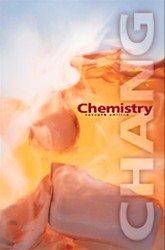 |  Chemistry, 7/e Raymond Chang,
Williams College
Atoms, Molecules, and Ions
Internet ExercisesPeriodic Chart
(http://www.shef.ac.uk:80/~chem/web-elements)
Use Alta Vista to determine
the following about the element Seaborgium:
- the symbol of the
element
- the atomic number
- the stability of
the element
- the Nobel chemist
for whom the element was named
Having obtained
the information above, answer the following questions:
- How many protons
are present in the nucleus of Seaborgium?
- If an atom of Seaborgium
has the same number of neutrons as protons, what is its mass number?
- Is it likely that
most Seaborgium atoms have equal numbers of protons and neutrons? [Hint:
You might want to look at a periodic chart (use the one at http://www.shef.ac.uk:80/~chem/web-elements ).
|
 |  |  | Periodic Chart
(http://www.shef.ac.uk:80/~chem/web-elements)
Use the Web Elements
periodic chart at http://www.shef.ac.uk:80/~chem/web-elements
to determine the number of stable isotopes of the fourth element in Group
IV. Interestingly, this element has the largest number of stable isotopes
of any element.
|
 |  |  | Chemcyclopedia
(http://pubs.acs.org/chemcy/)
Many inorganic compounds
are prepared in water. When the ions come together to make the solid compound,
water molecules are incorporated into the structure of the solid. For many
compounds these "hydrates" exist as well-defined compounds. Use the American
Chemical Society's (the largest professional organization of chemists in the
United States) publication, Chemcyclopedia, at pubs.acs.org/chemcy/
to determine how many different hydrates of copper sulfate are commercially
available (at least according to the source). Also answer the following questions:
- What is the formula
of copper sulfate?
- Use the format MX;#183;nH2 O
to indicate the formula of copper sulfate pentahydrate. (M=cation, X=anion)
- How do you suppose
you could prepare the anhydrous form of copper sulfate from one of the
hydrates?
|
 |  |  | Equations and More
(http://library.advanced.org/2923/)
The word "element" has
several meanings. To the layman, it probably means a simple form of matter
and conjures up phrases such as "trace elements" or "the element that prevents
tooth decay is fluorine". Chemistry students realize that at the atomic level
of one element is different from another because of the different number of
protons in the nucleus. They also know that in their uncombined or elemental
forms, they may exist as atoms, as molecules, or as metals. They may also
exist in all three states of matter. For example, at room temperature, elemental
fluorine is a gas, elemental bromine is a liquid, and elemental iodine is
a solid. Go to the site at http://library.advanced.org/2923/ .
Click on Equations and More and then on Diatomic Elements.
As you can see,
seven elements exist in their uncombined state as diatomic molecules. For
example, the nitrogen in the air we breathe is usually written as N2
to indicate that a molecule of elemental nitrogen contains two nitrogen atoms.
- Because oxygen exits
as a diatomic molecule, is it reasonable to suppose that sulfur would
also be diatomic?
- In fact, a number
of the nonmetals exist as molecules that are not diatomic. Sulfur exists
as a cyclic chain of eight atoms. Write a formula for sulfur, and draw
a structure for the molecule.
- Chemists sometimes
name these simple molecules by using a prefix to indicate how many atoms
are in one molecule. For example, N2 is called dinitrogen.
Use the prefixes on this same web page to name P4 .
- In the elemental
form, phosphorus exists as P4 molecules in which each phosphorus
is attached to three other phosphorus atoms. Draw a structure for this
molecule.
- Actually, many elements
exist in more than one elemental form, called allotropes. For example,
oxygen exists in two allotropic forms, O2 and O3 .
How are you familiar with O3?
|
 |  |  | Periodic Charts
(http://www.shef.ac.uk/~chem/web-elements/)
The web contains many
periodic charts. The one at http://www.shef.ac.uk/~chem/web-elements/
contains a variety of kinds of information about each element. Use the chart
to answer the following:
- What is the origin
of the symbol K for potassium? Why not use P or Po?
- Name the elements
in Group I.
- How do the ionization
energies vary for the Group I elements? Do all groups show this kind of
variation?
- How many electrons
would the cation of the element with an atomic weight of 24.305 have?
- How many electrons
would the anion of the element with 53 protons have?
|
|



 2002 McGraw-Hill Higher Education
2002 McGraw-Hill Higher Education

 2002 McGraw-Hill Higher Education
2002 McGraw-Hill Higher Education